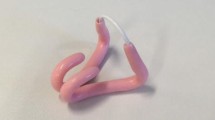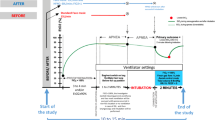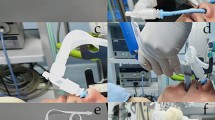Abstract
Purpose
Facemask ventilation during the induction of general anesthesia in paediatric patients remains a challenge as it may result in hypoxic conditions and gastric insufflation with subsequent regurgitation and aspiration. So far, it is unclear if pressure-controlled or manual facemask ventilation is preferable in children. We hypothesized that pressure-controlled ventilation in apnoeic children results in lower peak airway pressure and flow rates compared to manual ventilation at comparable respiratory rates and tidal volumes.
Methods
Sixty-two lung-healthy children undergoing scheduled ear-nose-throat surgery were included in the study. After the induction of anesthesia, the patient’s lungs were consecutively ventilated via a facemask in either manual or pressure-controlled mode, in randomized order. The primary outcome measure was peak airway pressure. Secondary outcome measures included positive end-expiratory pressure, airway compliance, tidal volume and airway flow.
Results
Data of 52 patients could be analyzed. Pressure-controlled ventilation resulted in a lower mean and peak inspiratory pressure (both p < 0.001), airway pressure amplitude (p = 0.01) and inspiratory peak flow rate (p = 0.005) compared to manual ventilation. The ratio of inspiration to expiration time was lower in pressure-controlled ventilation compared to manual ventilation (p < 0.001).
Conclusion
Pressure-controlled facemask ventilation during induction of anesthesia in pediatric patients results in lower airway pressure, and lower flow rates compared to manual ventilation, at comparable tidal and minute volumes.

Similar content being viewed by others
References
Augustine JA, Seidel DR, McCabe JB. Ventilation performance using a self-inflating anesthesia bag: effect of operator characteristics. Am J Emerg Med. 1987;5(4):267–70.
von Goedecke A, Voelckel WG, Wenzel V, Hormann C, Wagner-Berger HG, Dorges V, Lindner KH, Keller C. Mechanical versus manual ventilation via a face mask during the induction of anesthesia: a prospective, randomized, crossover study. Anesth Analg. 2004;98(1):260–3 (table of contents).
Wenzel V, Idris AH, Banner MJ, Kubilis PS, Williams JL Jr. Influence of tidal volume on the distribution of gas between the lungs and stomach in the nonintubated patient receiving positive-pressure ventilation. Crit Care Med. 1998;26(2):364–8.
Motas D, McDermott NB, VanSickle T, Friesen RH. Depth of consciousness and deep sedation attained in children as administered by nonanaesthesiologists in a children’s hospital. Paediatr Anaesth. 2004;14(3):256–60.
Gencorelli FJ, Fields RG, Litman RS. Complications during rapid sequence induction of general anesthesia in children: a benchmark study. Paediatr Anaesth. 2010;20(5):421–4.
Cook TM, MacDougall-Davis SR. Complications and failure of airway management. Br J Anaesth. 2012;109(Suppl 1):i68–85.
Cook TM, Woodall N, Frerk C. Major complications of airway management in the UK: results of the Fourth National Audit Project of the Royal College of Anaesthetists and the Difficult Airway Society. Part 1: anaesthesia. Br J Anaesth. 2011;106(5):617–31.
Practice guidelines for management of the difficult. airway: an updated report by the American Society of Anesthesiologists Task Force on Management of the Difficult Airway. Anesthesiology. 2003;98(5):1269–77.
Murat I, Constant I, Maud’huy H. Perioperative anaesthetic morbidity in children: a database of 24,165 anaesthetics over a 30-month period. Paediatr Anaesth. 2004;14(2):158–66.
Engelhardt T, Weiss M. A child with a difficult airway: what do I do next? Curr Opin Anaesthesiol. 2012;25(3):326–32.
Lagarde S, Semjen F, Nouette-Gaulain K, Masson F, Bordes M, Meymat Y, Cros AM. Facemask pressure-controlled ventilation in children: what is the pressure limit? Anesth Analg. 2010;110(6):1676–9.
Beck-Schimmer B, Bonvini JM. Bronchoaspiration: incidence, consequences and management. Eur J Anaesthesiol. 2011;28(2):78–84.
Flick RP, Schears GJ, Warner MA. Aspiration in pediatric anesthesia: is there a higher incidence compared with adults? Curr Opin Anaesthesiol. 2002;15(3):323–7.
Ho-Tai LM, Devitt JH, Noel AG, O’Donnell MP. Gas leak and gastric insufflation during controlled ventilation: face mask versus laryngeal mask airway. Can J Anaesth. 1998;45(3):206–11.
Feldman JM. Optimal ventilation of the anesthetized pediatric patient. Anesth Analg. 2015;120(1):165–75.
Humphreys S, Pham TM, Stocker C, Schibler A. The effect of induction of anesthesia and intubation on end-expiratory lung level and regional ventilation distribution in cardiac children. Paediatr Anaesth. 2011;21(8):887–93.
Acknowledgements
The authors like to thank Helen Engelstaedter for language editing, Daniel Steinmann for reviewing the manuscript and technical support, Christian Göttel for help with data collection and Manfred Olschewski for support in statistical analyses. This research did not receive any specific grant from funding agencies in the public, commercial, or not-for-profit sectors.
Author information
Authors and Affiliations
Corresponding author
Ethics declarations
Conflict of interest
None of the authors has any conflict of interest.
About this article
Cite this article
Goebel, U., Schumann, S. & Wirth, S. Peak airway pressure is lower during pressure-controlled than during manual facemask ventilation for induction of anesthesia in pediatric patients—a randomized, clinical crossover trial. J Anesth 33, 33–39 (2019). https://doi.org/10.1007/s00540-018-2580-y
Received:
Accepted:
Published:
Issue Date:
DOI: https://doi.org/10.1007/s00540-018-2580-y




